Specifications:
- Water Resistant to 10 BAR
- Time
- Altimeter/Depth
- Compass
- Barometer
- Thermometer
|
- Stopwatch
- Alarm
- EL Backlight
- Made in: Thailand
- Street Price: $120.00
|
From Casio's Website:
Powerful Triple Sensor technology goes everywhere you do. Digital Compass with Duplex LCD helps you find your position and plan your route, while the barometer/thermometer can help you predict what kind of weather lies ahead. Of course there’s the altimeter which can track altitude, cumulative ascent and decent in route to your destination. Triple Sensor, Duplex LCD, Auto EL Backlight. Brown Resin Band and Digital Dial Code. |
Supplier:
I purchased my example from eBay. I had been contemplating this watch for some time, but prices on the web vary from $100-200. That is a pretty wide margin. The sample I have was an "open box" or more accurately "no box" item from a watch vendor. It only came with a photocopied operators manual. This did not bother me in the slightest as long as the item was new. The box is rarely used again after the watch is received, and the manuals are quickly lost. Most manuals can be found online these days in the event you need to refer to it.
Casio refers to the internal "guts" of their watches at "modules". The Pathfinder PAG40-5V uses the 2271 Module. The operators manual can be found online HERE.
Packaging:
My sample was a "no box" so I cannot make any comment on the factory packaging.
Initial Impressions:
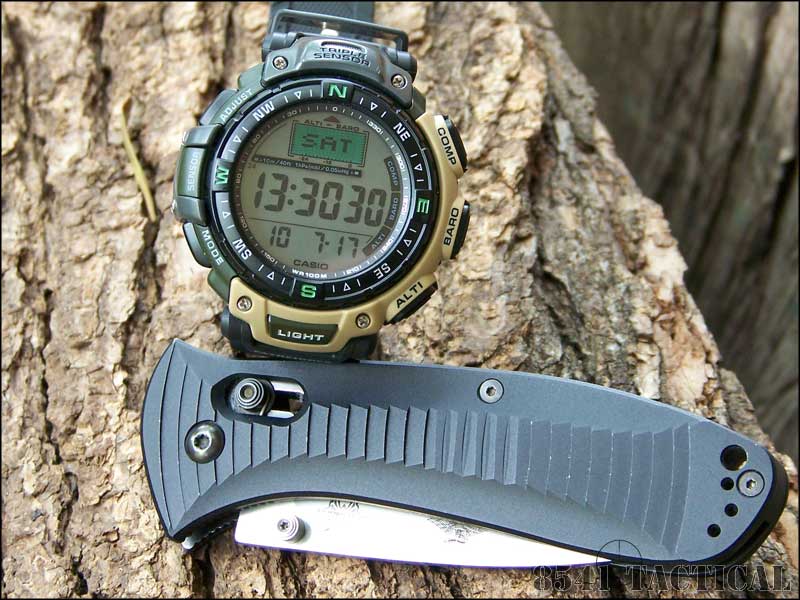 |
This is a huge watch. That is not a bad thing. The watch body is 2.25" from top to bottom. The benefit of this is that the main information displayed in each mode is 1/4" tall. Since this is a positive display with black characters on a silver background the information can be seen in low light conditions without the use of the backlight.
Shown next to a Benchmade Pardue 520 will give you an idea of it's size. The Pardue 520 is NOT a small knife.
The size doesn't bother me in the slightest because I have worn large watches since my infancy as a grunt. They just seem to work better.
In this case, size does not equate to weight. It weighs in at 2.5oz on my postal scale. |
The buttons are easy to press when wearing gloves, but appear to be well protected. The illumination button is prominent on the front of the watch and should be easy to get to when wearing BDU's and gloves.
This watch looks good. It's got a very utilitarian appearance which will appeal to readers of this website. Did I mention that this watch is BIG?
Operation:
I will not delve into the minute workings of the watch modes. Those are covered pretty well in the operators manual.
 |
Push the "COMP" button and the compass springs to life. A couple of seconds and it will read out which direction the 12 o'clock position of the watch is pointed. |
Push the "BARO" button and the main display will read out the Barometric Pressure. The sub-display will read out the temperature. The units can be set for metric or SAE. Both the pressure and temp calibration can be changed but the use of the "ADJUST" button. The Thermometer will not read correctly with the watch worn on the body. You will need to remove the watch and allow the temperature of the case to stabilize with the atmosphere. How long this takes will depend on how much difference there is between body temp and the atmosphere.
The top graph shows the trend in the Barometric Pressure. This can be useful for predicting weather.
I did not see a method to set the Barometer to read Station Pressure. I am assuming that setting the calibration until the baro agrees with my Kestrel on station pressure will suffice. |
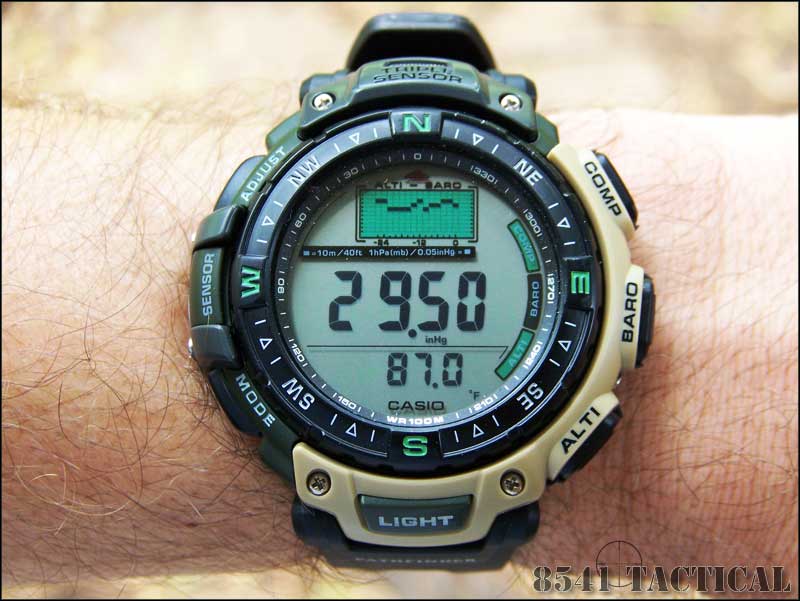 |
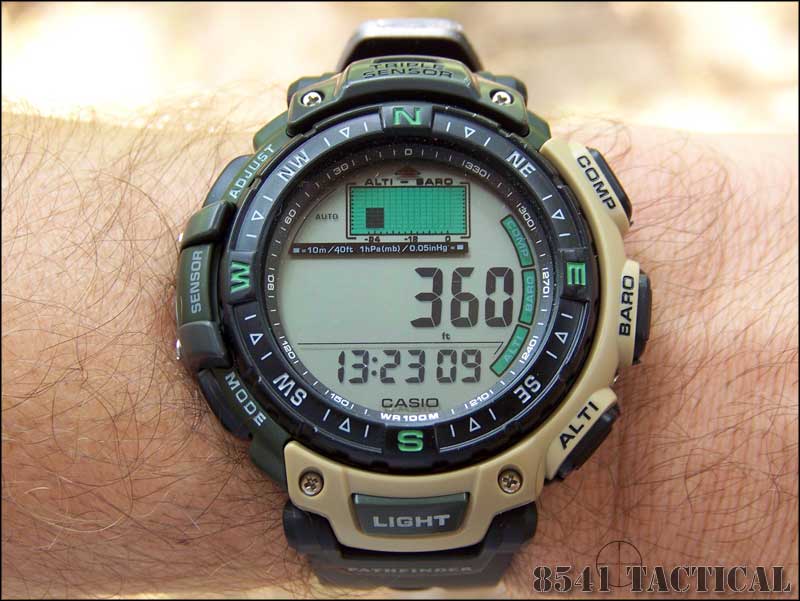 |
The "ALTI" button will yield the altitude based on the barometric pressure. In our sample the altitude was close with the factory calibration. I based this on a USGS Benchmark near my home.
The top bar graph displays your progress in ascent or descent. |
| Pressing the "MODE" button once puts the watch into the Record mode. It will display the Min and Max Altitudes. |
 |
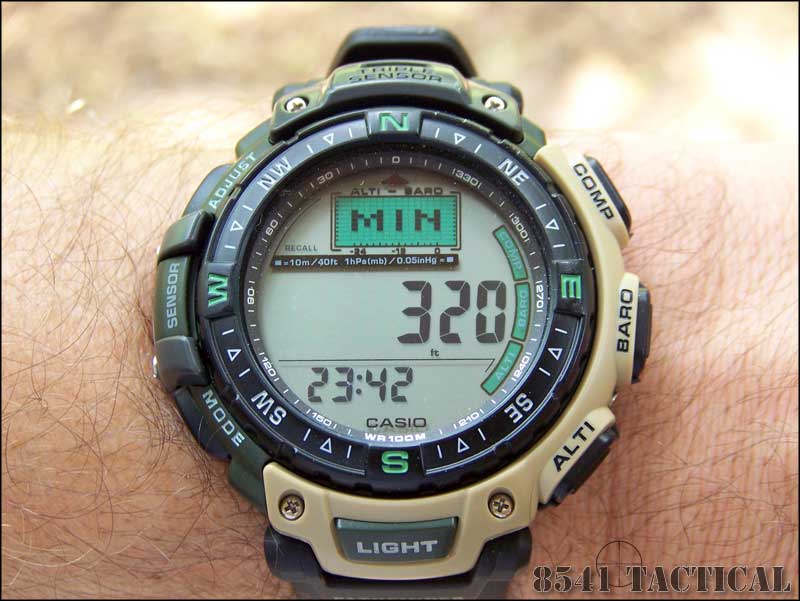 |
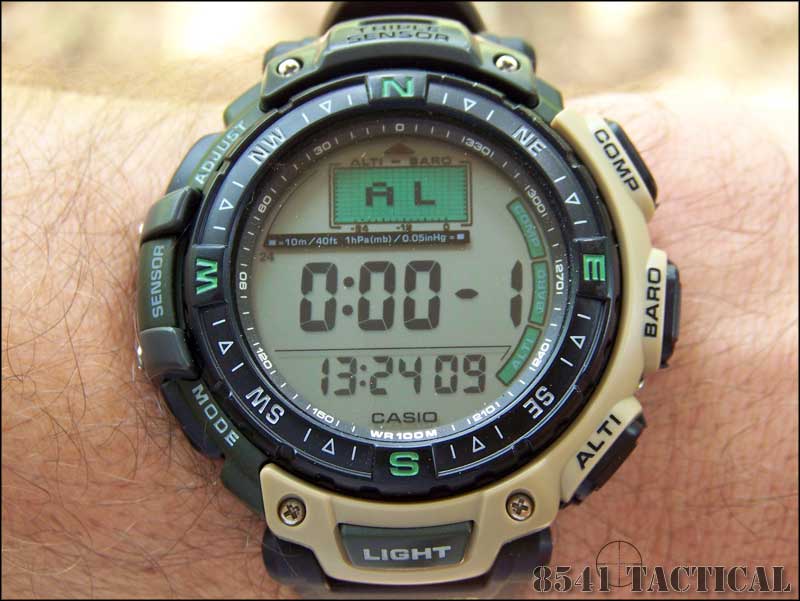 |
Pressing the "MODE" button again and you will be in the Alarm Mode. The PAG40-5V allows for five alarms. In the Alarm mode you can also set the hourly chime or disable it. |
| Pressing the "MODE" button again will place the watch into the Stopwatch mode. The Stopwatch has a rudimentary "LAP" button to freeze the lap time, but it does not appear to record the LAP time. |
 |
If at any point you pause in a Mode, when you press the "MODE" button again you will return to the TIME screen.
I will be doing some tests to see how closely the Casio PAG40-5V agrees with the Kestrel. Hopefully we can get close enough that the Pathfinder will be usable for long range dope calculations.
After a couple nights at work I have found that I really like this watch. It can be accidentally bumped into another mode during a scuffle, but you can exit any mode back to the time screen by pressing the "MODE" button. I did not notice a single time that the light was accidentally activated however from a tactical standpoint, if you are in a non-permissive environment you may want to make sure your gloves are the gauntlet style and cover the face of the watch.
One of the few dislikes I have of this watch is that the "key beeps" can not be shut off. The watch will beep when you change modes. It's a rather low volume and very noticeable at arms length, but we all know sounds are a whole lot louder in the dark of night.
I plan on adding to this review as I get some field time with the watch. So far after a couple nights of street patrol and one warrant service this watch is an acceptable addition to my work uniform. If it will be useful for tactical shooting has yet to be seen.
Update (07.26.10):
I calibrated the Barometer against my Kestrel to read Station Pressure. Station pressure (or Absolute Pressure) reads the pressure where I am standing without adjusting for altitude. This is advantageous in mountainous areas because it removes another variable from the shooting equation. Most devices including the info you get from the Weather Channel will read Barometric Pressure corrected for Sea Level. The Pathfinder reads pressure to 0.05 inHg. My Kestrel reads to 0.01 inHg. Bearing this difference in resolution in mind the Kestrel and Pathfinder have agreed as closely as possible every time I have checked them against each other.
I have checked the Pathfinder's compass against a Cammenga Non-Tritium version of the USGI Lensatic Compass. This is the exact same compass that I have used to navigate on several different continents with the exception of the radioactive tritium vials. I have found this compass to be very accurate. While comparing the two I was instantly reminded of the cardinal rule of compasses. KEEP THEM AWAY FROM MAGNETIC OR FERROUS MATERIAL!!! If you don't your bearing will be off. I felt rather stupid the first time I held both side by side and saw the bearings on the Pathfinder were 160* off. However it did demonstrate an interesting fact. The Pathfinder appears to be more susceptible to magnetic interference than the Cammenga. The Cammenga only varied by a couple of degrees.
Once I separated the two I noticed that the Pathfinder was off a bit. This was not unexpected. I had not calibrated the Pathfinder yet. I pulled out the instructions and followed the instructions for bi-directional calibration. This is the one you want to use if you are lost. Bi-directional calibration does not require you to know which direction is magnetic north. You simply pont the watch in one direction, press a button, then point the watch 180 degrees the other way and press the button again. If you are accurate, the compass will be too.
After calibrating the Pathfinder, it and the Cammenga agreed on magnetic north. The directions for the Pathfinder stated that you can calibrate it using the Northerly calibration to show either true north or magnetic north. I have always used mechanical compasses for navigation. They point to magnetic north, so I choose to keep the Pathfinder calibrated to magnetic north.
Lastly I checked the thermometer. To accurately measure ambient temperature you need to remove the watch from your body and allow it to normalize. The operators manual states that you should wait for twenty minutes. Obviously how long you wait will depend on how much difference there is between body temperature and ambient temp. If ambient is 98.6 or so you shouldn't have to wait long. If ambient temp is below zero, you may have to wait a bit. This is one spot where the Kestrel excels. I can take it out of a hot trunk, set it in the shade and the temp will stabilize rather quickly.
If you know that you will be using the Pathfinder for shooting calculations, then I would suggest removing it from your wrist and securing it to a pack strap or other area where it will be isolated from body heat and exposed to the air. Do so at least twenty minutes prior to moving into your FFP.
To check the calibration on the pathfinder I simply set it and the Kestrel on the desk in my air conditioned office for a good long while. After some time the readings were fairly close. They were within a degree or two, which is acceptable for trajectory calculations.
Update (08.01.10):
During a SWAT Callout in the early hours of the morning I grabbed by bug juice and applied a couple of sprays. The bug spray I am partial to is 100% DEET. It works very well. There is just one problem. It doesn't like plastic much. I didn't even think about the watch. It was never an issue I had to worry about.
The Callout went on for a couple hours and ended in a peaceful resolution. I came home and went about putting up my gear and fixing breakfast before I woke up my family by jumping in the shower. This placed the exposure of the watch to the bug spray at about five hours before I showered (with the watch on).
This afternoon I picked up the watch and looked at it. I noticed that anywhere the bug spray contacted the band it made it shiny. I initially thought this was just because I had not successfully washed the oils from the watch. I gave it a good scrubbing with some dish detergent, but it appears that the bug juice actually burned the plastic of the band. Upon closer inspection there were also some spots on the plastic of the case that has turned shiny. This does not affect the function or utility of the watch and the crystal was not affected, but it is something I will keep in mind the next time I am spraying the bug juice.
Back to Reviews
|


